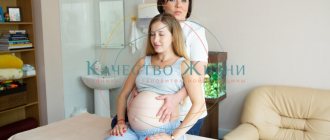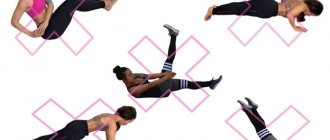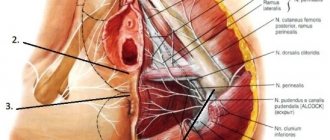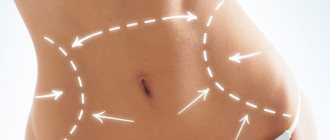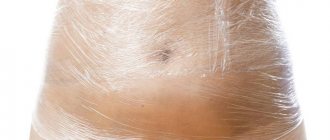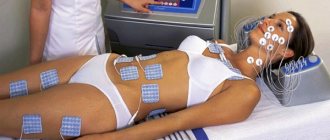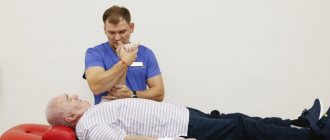Diastasis is a stretching of the tendon plate (in medicine also called the “white line”), which connects the vertical rectus abdominis muscles. It consists of elastic fibers that can weaken for various reasons. This causes the vertical abdominal muscles to separate. The problem can be solved with the help of abdominoplasty with suturing of diastasis, that is, correction of stretching.
The disease is somewhat reminiscent of the divergence of seams on clothing. They stretch when they weaken and no longer fit well together. A similar situation occurs with the white line of the abdomen. Pathology may look different depending on its severity. In some it manifests itself through a “bloated” belly, while in others it is a strongly inverted navel.
You can test for diastasis yourself at home. To do this, lie on the floor and take a position as if you are going to pump your abs. Leave one hand under your head, and with the other, feel your stomach along the center line to the groin. To increase muscle tension and more accurately determine their relief, you should raise your upper body and lean forward slightly, as if you were pumping your abs.
The normal width of the white line is 0.5-3 cm. If it is larger, it is considered diastasis. Then a gap will be felt (especially in the navel area). When there is no pathology, this gap is weakly expressed or absent at all.
Diastasis in men and women
According to statistics, abdominal diastasis occurs in two out of 200 people. It occurs in men, but it is mainly a female disease, which is especially common after childbirth and cesarean section. In addition, doctors identify the following reasons for the divergence of the vertical abdominal muscles:
- increased physical activity;
- hereditary increased extensibility of ligaments;
- rapid and intense weight loss;
- obesity.
People who often suffer from constipation and a hacking cough are also at risk.
Regardless of the origin, the problem should be addressed as soon as possible. The patient needs to consult a doctor and remove the diastasis. It is advisable not to delay solving the problem, otherwise an abdominal hernia may develop.
Stretching of the linea alba during pregnancy
Stretching of the vertical abdominal muscles during pregnancy is associated with the characteristics of your body. As the fetus grows, it takes up more and more space in the woman's uterus. She pushes the organs apart, and the vertical abdominal muscles also move apart.
After childbirth, the body recovers over time, but it also happens that the sprain does not disappear. What remains is a flabby belly, which does not decorate a woman.
Diastasis can appear even 4 months after birth if the white tendon plate in the abdominal area has decreased its ability to contract. If after pregnancy a young mother begins to load her body too early or intensively, this can also provoke pathology.
An effective way to avoid the development of diastasis after childbirth is sports. It is advisable to regularly devote time to physical activity several months before pregnancy so that the muscular system is properly strengthened. While waiting for the baby, it is also recommended to do exercises regularly, if your health allows.
Some doctors also recommend wearing a bandage during pregnancy as a preventative measure. It cannot be guaranteed that it will definitely help to avoid pathology, but it will significantly relieve the burden. The main thing is to select and wear it as prescribed by your doctor.
Possible consequences
Usually, for abdominoplasty with diastasis, people turn to doctors complaining of an unattractive figure, but this pathology is dangerous to a greater extent not because of the violation of aesthetics, but because of the negative consequences for health. In advanced forms, it can cause unpleasant complications:
- pain in the back and abdomen, especially during exercise;
- disruptions in the functioning of the digestive, respiratory and circulatory systems;
- increased risk of hernia formation;
- prolapse of internal organs.
No matter whether you are worried about an unattractive figure or painful symptoms, it is advisable to consult a doctor. You can order an examination at our surgical clinic in Novorossiysk, and a specialist will recommend treatment tactics. We offer the full range of services necessary to completely eliminate the pathology.
Cost of abdominal plastic surgery
| SERVICE | PRICE |
| Specialist consultation | For free |
| Mini-plasty without umbilical ring transfer (anesthesia and 1 day of hospitalization included) | RUB 105,000 |
| Abdominoplasty with umbilical ring transfer for tissue ptosis of the 1st degree of complexity (anesthesia and 1 day of hospitalization included) | RUB 155,000 |
| Abdominoplasty with umbilical ring transfer for tissue ptosis of the 2nd degree of complexity (anesthesia and 1 day of hospitalization included) | RUB 165,000 |
| Abdominoplasty with umbilical ring transfer for tissue ptosis of the 3rd degree of complexity (anesthesia and 1 day of hospitalization included) | 180,000 rub. |
| Liposuction – 1 zone | 15,000 rub. |
When is surgery needed?
Doctors accurately identify diastasis and determine its degree using ultrasound. Thanks to this study, the width of the white line can be accurately determined.
There are three stages of diastasis:
- Stage I - discrepancy of 1-7 cm - mild back pain, constipation, flatulence, attacks of nausea, discomfort while walking, difficulty breathing, worsening digestion may appear;
- Stage II – discrepancy of 7-10 cm – the vertical muscles relax so much that an unsightly shape appears in the abdominal area;
- Stage III – discrepancy greater than 10 cm – ability to work is sharply limited, the figure is unaesthetic and saggy, the muscles are almost completely atrophied.
In the first degree, surgical plastic surgery is not necessary; you can get by with a set of exercises to strengthen connective tissue, which are prescribed by a physical therapy doctor. You just can’t select the loads yourself, otherwise you can worsen the situation.
In the second stage, abdominoplasty is indicated to eliminate diastasis of the rectus abdominis muscles, and in the third stage, the operation must be performed, otherwise the patient’s condition may be worsened by hernias. In the most advanced cases, there is a risk of intestinal obstruction, strangulation and necrosis, which are treated with emergency surgery to remove the affected area.
When diastasis is mild and has no complications, the patient can order abdominoplasty at his own discretion. It is recommended to do this to avoid complications in the future and regain a beautiful figure.
Rehabilitation
The rehabilitation period is relatively easy. At first there is swelling, hematomas, and pain. The first ones gradually go away on their own, and the pain is relieved with a drug prescribed by the doctor.
In the first month, you should not lift anything heavier than 3 kg. For two months you should not overheat, go to the sauna, sauna, or take a hot bath. The body must be protected from the sun; you cannot sunbathe or swim in the pool. Sports are also banned for two months.
The bandage is worn for 2-3 months.
Diastasis is a serious problem that women most often face after pregnancy. It is impossible to connect the separated muscles of the “white line” either with diets or exercises. SM-Clinic surgeons come to the rescue, restoring beauty and self-confidence.
Yakimov Dmitry Konstantinovich
Doctor of the highest category. Candidate of Medical Sciences. Member of the Society of Plastic Surgeons. Author of more than 30 works in the field of surgery, teacher at the Military Medical Academy.
How is surgery to eliminate diastasis recti performed?
Before plastic surgery for diastasis recti, the patient needs to have an ECG and some tests. Three days before the operation, you need to exclude fatty, spicy and fried foods from your diet, do not drink alcohol, and stop smoking. All tests before hospitalization can be ordered at our clinic.
Abdominoplasty for diastasis of the rectus abdominis muscles is a very complex operation that takes place under anesthesia for 2-5 hours. The surgeon removes excess skin and fat, returns the abdominal muscles to their normal position, and can move the navel if necessary.
Taking into account the severity of diastasis, different types of surgery may be necessary:
- endoscopic abdominoplasty – used to suturing muscles without removing excess skin. Plastic surgery occurs through small incisions, the seams are almost invisible after this. Approximate time – 2 hours;
- mini-abdominoplasty - a small surgical intervention on the lower abdominal wall is indicated for normal body fat and good muscle tone. It is aimed primarily at removing excess skin; liposuction is allowed. Approximate time – 2 hours;
- standard abdominoplasty – performed for obesity and severe stretching of the skin. This type of plastic surgery includes removal of skin stretch marks, excess fat, suturing of muscles, and possible displacement of the navel. Approximate time – 4 hours.
The sooner you seek the services of a surgeon, the less surgical trauma and the faster the rehabilitation period. Thanks to the proven technique and many years of experience of our doctors, you can count on excellent cosmetic results. With standard abdominoplasty to eliminate diastasis, the incision is made as low as possible so that in normal life it is hidden under underwear. When stitching, special threads are used so that the seam is almost invisible.
General indications
Without this operation, it is impossible to return the abdomen to its normal aesthetic appearance in the following cases:
- loose skin after childbirth
- excess skin fold
- increasing the distance between the rectus abdominis muscles
- umbilical, inguinal hernia or hernial formation of the white line (the place where the aponeuroses that “wrap” the rectus muscles grow together)
- rough postoperative scars in the hypogastric area
- striatal deformation of the integumentary tissue (stretch marks)
- the impossibility of isolated liposuction due to a significant decrease in the collagen-elastin reserve in the integument of the abdominal wall (skin like a “baked apple”).
Whatever surgical technique is chosen, the efforts of the surgeons at the SOLEI Plastic and Aesthetic Surgery Clinic in Podolsk are to ensure that abdominoplasty before and after makes a significant visible difference. So that the stomach becomes ideally shaped, toned, without excess tissue, elastic and attractive.
Recovery after surgery
Recovery after surgery depends on the type of surgery. On average it takes 1-4 weeks.
With endoscopic ablominoplasty of diastasis:
- the patient feels little or no pain;
- complications occur extremely rarely;
- physical fitness returns within a week;
- almost no marks on the skin.
You can leave the hospital the very next day after the correction, but stress must be avoided for a month.
With standard abdominal abdominoplasty with suturing of diastasis:
- the patient must remain in the hospital for several days;
- there is often pain, so analgesics are prescribed;
- stitches are removed after about 7-8 days;
- It is necessary to abstain from physical activity for at least 3 months and not lift weights weighing more than 5-10 kg. After this time, you can return to your normal rhythm of life.
For all types of surgical intervention, wearing a bandage and/or surgical underwear is prescribed for at least 1 month.
Preparation
The preparatory stage begins with an examination, which includes a number of laboratory and instrumental studies. The patient is sent for blood tests (general and biochemical, blood type, Rh factor, as well as for HIV, hepatitis and sexually transmitted diseases). Along with this, coagulability indicators are necessarily examined (a coagulogram is performed).
To monitor general somatic health, the following are prescribed:
- electrocardiography;
- fluorography or chest x-ray;
- Ultrasound of the abdominal cavity, etc.
You should inform the surgeon in advance about undergoing treatment with anticoagulants and stop taking these medications several days before the expected date of surgery.
It is also necessary to consult with our anesthesiologist, who, based on the results of the examination, will recommend the safest type of anesthesia in each specific case.
results
After suturing diastasis, you get not only a healthy body, without pathologies, but also an aesthetic figure:
- skin stretch marks are removed;
- fat is removed;
- Abdominal flabbiness is eliminated;
- the shape and location of the navel changes;
- a pronounced waist is formed;
- a beautiful muscle relief is created.
Advanced suturing techniques reduce recovery time. After healing, barely noticeable scars and scratches remain on the body, which are hidden even by the smallest swimsuit.
Possibility of pregnancy after diastasis abdominoplasty
Getting rid of stretched linea alba before pregnancy is not only possible, but also necessary. Do not be afraid to apply for diastasis abdominoplasty after childbirth if you are still planning to have children. If the pathology remains, it can provoke oxygen starvation of the fetus and complicated childbirth.
Do not rush to look for diastasis immediately after childbirth; not every pregnancy leads to such complications, especially if it was the first. Wait a few weeks for your body to recover. Your figure may gradually return to normal, but if your belly remains soft and falls out, you probably have diastasis. Then you can turn to the services of a surgeon for plastic surgery.
After surgery, it is advisable to wait a year before conceiving a child so that the body can recover. It is advisable to consult your doctor first. In case of extensive abdominoplasty with elimination of diastasis, the surgeon may advise postponing pregnancy for a certain period of time.
What is the basis for choosing abdominoplasty as a method of aesthetic correction?
The appearance of the space from the end of the sternum to the pubis depends on three main factors:
- volume of fatty hypodermis
- skin conditions in a given location
- situation with the abdominal muscles.
Normally, the abdominal frontal wall has a diamond shape. The rounding of the outer walls of the abdominal cavity means that the rectus muscles (those that form the “cubes”) of the abdomen have moved away, making the tendon area that lies in the middle wider. In women, this is most often provoked by pregnancy, in men – by obesity, accumulation of effusion in the abdominal cavity, and heavy muscular work. By eliminating the increased intra-abdominal pressure, the muscles can be directed again to their physiological (naturally assigned from birth) localization, but this ability is subject to the individual characteristics of the muscle structure.
The shape of the tummy may also change with sagging (ptosis) of the skin of its anterior wall. On the degree of tissue sagging and discrepancy mm. recti (direct muscles) and is based on the choice of surgical technique by which tummy tuck will be performed after childbirth or weight loss.
